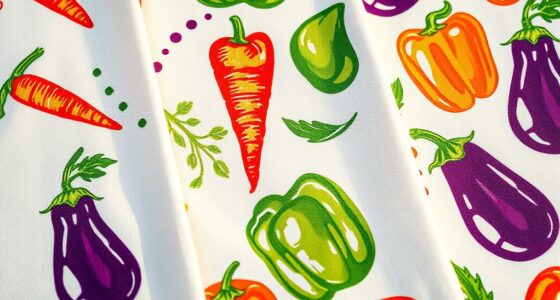Transforming everyday objects through upcycling lets you turn discarded items into beautiful, functional treasures. You can repurpose old furniture, glass jars, scrap wood, and textiles into unique crafts using eco-friendly materials like biodegradable paints and natural adhesives. These projects reduce waste, minimize resource use, and showcase your creativity. By making small changes, you promote sustainability and personal style. Keep exploring, and you’ll discover even more inspiring ideas to make the most of what you already have.
Key Takeaways
- Convert old furniture into stylish, functional pieces using sanding, painting, and eco-friendly finishes.
- Repurpose glass jars into decorative lanterns or storage containers with natural twine and biodegradable adhesives.
- Transform worn textiles into reusable bags or cushion covers, incorporating natural dyes and sustainable fabrics.
- Use scrap wood to create garden planters or small furniture projects with eco-friendly paints and sealants.
- Incorporate natural materials like oils, biodegradable paints, and sustainable fibers to ensure environmentally conscious upcycling.

Have you ever wondered how to transform old, unused items into something new and useful? Upcycling offers an exciting way to do just that, turning everyday objects into treasures while helping the environment. The key is mastering recycling techniques that breathe new life into items you might otherwise toss away. Instead of discarding worn-out furniture, glass jars, or scrap wood, you can reimagine them with creativity and purpose. Using eco friendly materials not only enhances your project’s sustainability but also ensures you’re making thoughtful choices that benefit the planet.
Start by evaluating what you have around the house. Old pallets, for example, can become charming coffee tables or garden planters. Sand down rough edges, then paint or stain them with eco friendly materials like natural oils or biodegradable paints. These materials are safe for both you and the environment, and they add a rustic charm to your creations. Similarly, glass jars can be transformed into stylish storage solutions or decorative lanterns. Clean them thoroughly, then decorate with natural twine or recycled fabric, securing lids with eco friendly adhesives. The possibilities are endless, and the process is rewarding because you’re reducing waste.
When working with textiles or fabrics, consider repurposing worn-out clothing into reusable shopping bags or cushion covers. Choose natural fibers like cotton or linen, which are biodegradable and eco friendly. These materials are easy to sew and customize, allowing you to add personal touches. If you’re into gardening, old tires can be painted and turned into vibrant planters. Use non-toxic, eco friendly paints to avoid harming plants or soil. Filling these with compost or soil turns discarded objects into functional and attractive garden features.
Incorporating recycling techniques into your upcycling projects encourages a mindful approach. Instead of buying new items, think about how existing materials can be repurposed. This not only reduces landfill waste but also minimizes the demand for new resources, which often involve energy-intensive manufacturing processes. Opt for eco friendly materials whenever possible—like natural adhesives, biodegradable paints, or sustainably sourced fibers—to ensure your upcycling efforts are genuinely eco-conscious. These choices make your projects more sustainable and set an example for others to follow.
Additionally, selecting preppy dog names can add a touch of sophistication and personality to your pet’s identity, reflecting your own eco-conscious values and style. Upcycling isn’t just about saving money or reducing waste; it’s about expressing your creativity and making a positive impact. With the right recycling techniques and eco friendly materials, you can transform ordinary objects into extraordinary pieces that reflect your style and values. Every project becomes a statement of sustainability, showcasing how small changes can lead to a more eco-friendly lifestyle. So grab those old items, gather your supplies, and start creating something beautiful—your eco-conscious journey begins now.
Frequently Asked Questions
What Are the Best Tools for Beginners in Upcycling?
You should start with basic tools like scissors, a utility knife, sandpaper, and a hot glue gun for upcycling. These are perfect for working with sustainable materials like wood, fabric, and glass. Attending upcycling workshops can teach you techniques and safety tips, making your projects easier. As you gain experience, you can invest in more specialized tools, but these essentials are great for beginners to get started confidently.
How Do I Choose Items Suitable for Upcycling Projects?
You’re on the right track by looking for items that have good bones. Focus on objects that are sturdy, like old jars or wooden crates, perfect for recycling art and creative storage. Avoid fragile or heavily damaged pieces, as they may be more trouble than they’re worth. Think about how the item can be transformed, and choose objects that inspire your creativity and fit your upcycling vision.
Are There Eco-Friendly Paints and Finishes for Upcycling?
Yes, there are eco-friendly paints and sustainable finishes perfect for upcycling. You can choose water-based paints, which emit fewer volatile organic compounds (VOCs), making them safer for the environment. Look for finishes labeled as eco-friendly or non-toxic to guarantee minimal environmental impact. Using these options helps you create beautiful, sustainable projects while reducing your carbon footprint. So, always check labels and opt for environmentally conscious products in your upcycling journey.
How Can I Ensure Safety During Upcycling Activities?
You can guarantee safety during upcycling by wearing proper safety gear like gloves, goggles, and masks, which act as your first line of defense against hazards. Always stay aware of potential dangers, such as sharp tools, fumes, or unstable surfaces, and work in well-ventilated areas. Keep a clean workspace, follow instructions carefully, and never rush, so you minimize risks and create your treasures safely.
What Are Some Budget-Friendly Upcycling Project Ideas?
You can create budget-friendly upcycling projects by using simple recycling techniques like turning glass jars into storage containers or tin cans into planters. Get creative with old furniture, repainting or repurposing it for extra storage. Look around your home for everyday objects and transform them into stylish, functional pieces. These projects are cost-effective, eco-friendly, and perfect for developing creative storage solutions without spending much.
Conclusion
Remember, one person’s trash is another’s treasure. By embracing upcycling, you not only give new life to everyday objects but also help protect the environment. With a little creativity and effort, you can turn simple items into beautiful, functional treasures. So go ahead, start your own upcycling project today—because as the saying goes, “Waste not, want not.” Your small actions can make a big difference in creating a more sustainable world.








